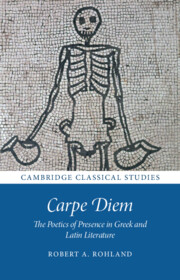Book contents
- Carpe Diem
- Cambridge Classical Studies
- Carpe Diem
- Copyright page
- Dedication
- Contents
- Figures
- Acknowledgements
- A Note on Ancient Texts and Translations
- Abbreviations
- Introduction In Search of Present Time
- 1 The Archaeology of Carpe Diem
- 2 A Moveable Feast
- 3 Gathering Leaves
- 4 The Pleasure of Images
- 5 As Is the Generation of Leaves, So Are the Generations of Cows, Mice, and Gigolos
- Epilogue
- Bibliography
- General Index
- Index Locorum
- References
Bibliography
Published online by Cambridge University Press: 18 November 2022
- Carpe Diem
- Cambridge Classical Studies
- Carpe Diem
- Copyright page
- Dedication
- Contents
- Figures
- Acknowledgements
- A Note on Ancient Texts and Translations
- Abbreviations
- Introduction In Search of Present Time
- 1 The Archaeology of Carpe Diem
- 2 A Moveable Feast
- 3 Gathering Leaves
- 4 The Pleasure of Images
- 5 As Is the Generation of Leaves, So Are the Generations of Cows, Mice, and Gigolos
- Epilogue
- Bibliography
- General Index
- Index Locorum
- References
Summary
- Type
- Chapter
- Information
- Carpe DiemThe Poetics of Presence in Greek and Latin Literature, pp. 239 - 281Publisher: Cambridge University PressPrint publication year: 2022
- Creative Commons
- This content is Open Access and distributed under the terms of the Creative Commons Attribution licence CC-BY-NC-ND 4.0 https://creativecommons.org/cclicenses/

